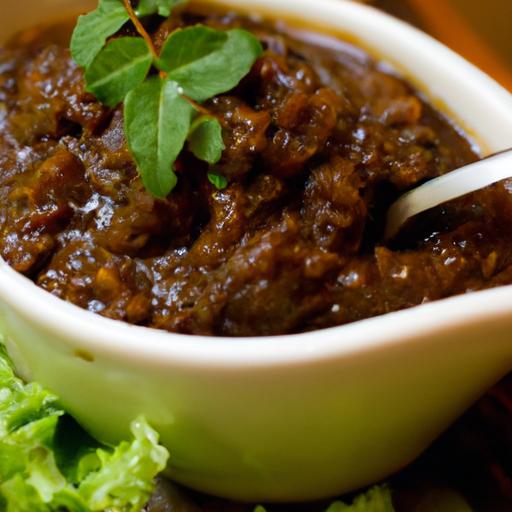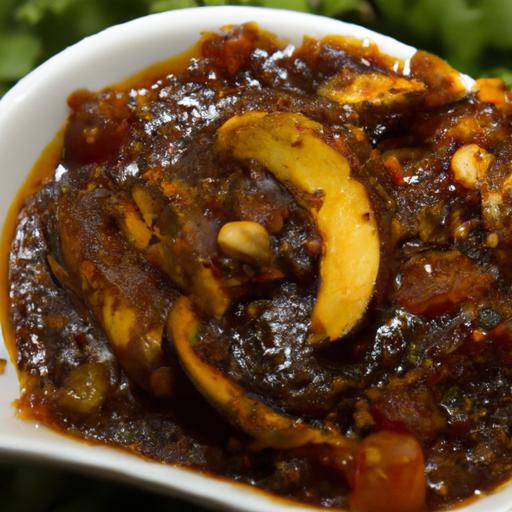In the vibrant tapestry of global cuisine, few flavors evoke as much nostalgia and delight as the tangy allure of tamarind chutney. This versatile condiment, with its harmonious blend of sweet, sour, and spicy notes, has long been a cherished staple in kitchens from bustling street markets to cozy family dinners. “Tangy Traditions: Crafting Perfect Tamarind Chutney at Home” invites you on a flavorful journey to master this timeless recipe, unlocking the secrets behind its rich history, bold taste, and simple, fresh ingredients. Whether you’re a seasoned cook or a curious food lover, preparing tamarind chutney at home promises not only a burst of exotic flavor but also a deeper connection to culinary tradition. Get ready to stir, simmer, and savor a chutney that’s as vibrant as the cultures it represents.
Tangy Traditions: Crafting Perfect Tamarind Chutney at Home unveils the rich tapestry of flavors and heritage wrapped in this iconic sauce. This chutney, a vibrant symphony of sweet and spicy notes, has long held a cherished place in Indian, Southeast Asian, and Middle Eastern kitchens, where tamarind pods transform humble meals into unforgettable feasts. From street-side chaats to royal banquets, the chutney’s allure stems not only from its taste but also from its ability to tell stories of ancient trade routes, cultural exchange, and culinary artistry.
Prep and Cook Time
Preparation: 15 minutes | Cooking: 25 minutes | Total: 40 minutes
Yield
Approximately 2 cups (about 8 servings)
Difficulty Level
Medium – Perfect for home cooks ready to experiment with balancing layers of bold flavors.
Ingredients
- 100g fresh tamarind pods (or ½ cup tamarind paste for convenience)
- 1 cup water (for soaking tamarind)
- ⅓ cup jaggery (or dark brown sugar for sweetness)
- 1 tsp roasted cumin powder
- 1 tsp red chili powder (adjust to taste)
- ½ tsp black salt (kala namak, adds a smoky tang)
- ½ tsp ginger powder (or freshly grated ginger, 1 tsp)
- 2 tbsp finely chopped fresh coriander (optional garnish)
- 1 tbsp oil (neutral vegetable oil or mustard oil for authentic aroma)
Instructions
- Prepare tamarind pulp: Gently break open the tamarind pods, remove seeds and fibers. Soak the tamarind in 1 cup of warm water for 15 minutes until soft. Using your fingers or a spoon, mash the pulp thoroughly, then strain it through a sieve into a bowl, extracting every bit of tangy goodness.
- Cook the base: Heat oil in a non-stick saucepan over medium flame. Pour in the tamarind water and bring it to a gentle simmer.
- Add sweetness and spices: Stir in the jaggery until dissolved, followed by the roasted cumin powder, red chili powder, black salt, and ginger powder. Keep stirring intermittently to avoid burning on the bottom.
- Reduce and thicken: Allow the chutney to simmer on low heat for 15-20 minutes, stirring regularly. The mixture should thicken to a syrupy consistency that lightly coats the back of a spoon.
- Adjust flavors: Taste your creation. Tamarind chutney is an art of balance – adjust sweetness or spice by adding jaggery or chili powder slowly until the desired harmony is achieved.
- Cool and store: Remove from heat and let cool completely. Transfer to a sterilized jar or airtight container. Garnish with finely chopped fresh coriander for an herbaceous pop if desired.
Chef’s Notes and Tips for Success
- For freshest flavor: Always select tamarind pods that are plump and slightly soft to the touch. Avoid dry or overly brittle pods, as they yield less pulp and flavor.
- If using tamarind paste, choose an additive-free, organic brand for cleaner notes.
- Balancing act: Remember tamarind’s natural tartness is bright and assertive-adjust your jaggery carefully in small increments to prevent overpowering the spice.
- Make-ahead magic: This chutney deepens in flavor after 24 hours refrigerated. Store it in a glass jar and it’ll keep freshness for up to 2 weeks.
- Substitution insight: Black salt is optional but highly recommended for its signature sulfurous tang. Regular salt can be used, but the flavor will be different.
Serving Suggestions
This chutney shines as a dipping companion to crispy samosas, pakoras, and grilled meats. Drizzle it over ragda pattice or folded into chaat bowls to infuse an irresistible zing. For a fresh twist, swirl a spoonful on top of creamy yogurt or dal for contrasting layers of taste. Garnish with a sprinkle of pomegranate seeds or toasted sesame for dazzling texture and color.

| Nutrient | Per 2 Tbsp Serving |
|---|---|
| Calories | 45 kcal |
| Protein | 0.3 g |
| Carbohydrates | 12 g |
| Fat | 0.1 g |
For those curious to explore more about the rich heritage of Indian condiments, don’t miss our guide to traditional Indian chutneys, a perfect companion to deepen your culinary journey. Through simple techniques and authentic ingredients, you can bring the captivating world of tamarind chutney into your home kitchen – vibrant, flavorful, and steeped in tradition.
Q&A
Q&A: Tangy Traditions – Crafting Perfect Tamarind Chutney at Home
Q1: What makes tamarind chutney a beloved staple in many cuisines?
A: Tamarind chutney is cherished for its vibrant tanginess balanced with sweet undertones, creating a symphony of flavors that dance on the palate. Its unique blend of sour, sweet, and spicy notes complements a variety of dishes, from savory snacks to grilled meats, making it a versatile and timeless condiment.
Q2: What are the essential ingredients needed to make authentic tamarind chutney?
A: At its heart, tamarind chutney requires tamarind pulp-either fresh or concentrated-combined with sugar or jaggery for sweetness. Spices like roasted cumin, ginger powder, and chili powder add warmth and depth, while a pinch of salt enhances overall flavor. Some variations include dates or raisins for extra richness.
Q3: How do I prepare tamarind pulp from scratch?
A: Begin by soaking tamarind pods or block in warm water for 30-60 minutes until soft. Then, gently mash and strain the mixture to separate the pulp from fibers and seeds. This fresh pulp is the soul of your chutney, offering vibrant acidity that store-bought concentrates often can’t match.
Q4: What’s the secret to achieving the perfect balance between tangy and sweet?
A: The key lies in gradual adjustments. Start by simmering your tamarind pulp with sugar or jaggery slowly, tasting frequently. The natural tartness of tamarind can be intense, so adding sweeteners a little at a time lets you find that harmonious midpoint where zest and sweetness whisper in delicious harmony.
Q5: Can I customize tamarind chutney to suit my taste or dietary needs?
A: Absolutely! If you prefer a spicier kick, ramp up the chili powder or add freshly chopped green chilies. For a gluten-free or vegan treat, stick to natural sweeteners like jaggery or maple syrup. Experimenting with ingredients like black salt, cinnamon, or even fresh herbs can create exciting regional twists.
Q6: How should I store homemade tamarind chutney to keep its freshness?
A: Store your chutney in a clean, airtight jar and refrigerate. Properly stored, it typically lasts up to two weeks. For longer preservation, consider freezing in small portions. The chutney may thicken over time; simply stir in a little warm water before serving to restore its perfect consistency.
Q7: What dishes best showcase homemade tamarind chutney?
A: Tamarind chutney shines alongside crispy samosas, pakoras, and chaat. It also makes a delightful drizzle over grilled meats, roasted vegetables, or even as a tangy dipping sauce for fried snacks. Its versatility means it can elevate everything from street-style eats to elegant appetizers.
Q8: Any final tips for beginners embarking on their tamarind chutney journey?
A: Be patient and savor the process-crafting tamarind chutney is as much about tradition as it is flavor. Taste as you go, trust your instincts, and don’t hesitate to make the recipe your own. Each batch is an opportunity to connect with centuries of tangy tradition right in your kitchen.
To Conclude
As the vibrant tang of tamarind lingers on your palate, you’ll realize that crafting the perfect tamarind chutney at home is more than just a recipe-it’s a delicious journey through time-honored traditions and bold flavors. By mastering this zesty condiment, you not only elevate your meals but also embrace a piece of culinary heritage that’s as versatile as it is unforgettable. So gather your ingredients, stir in a little patience, and let your kitchen be filled with the irresistible aroma of tangy goodness. Whether drizzled over snacks or paired with your favorite dishes, homemade tamarind chutney promises to be the flavorful twist that transforms everyday bites into extraordinary experiences. Happy cooking!


